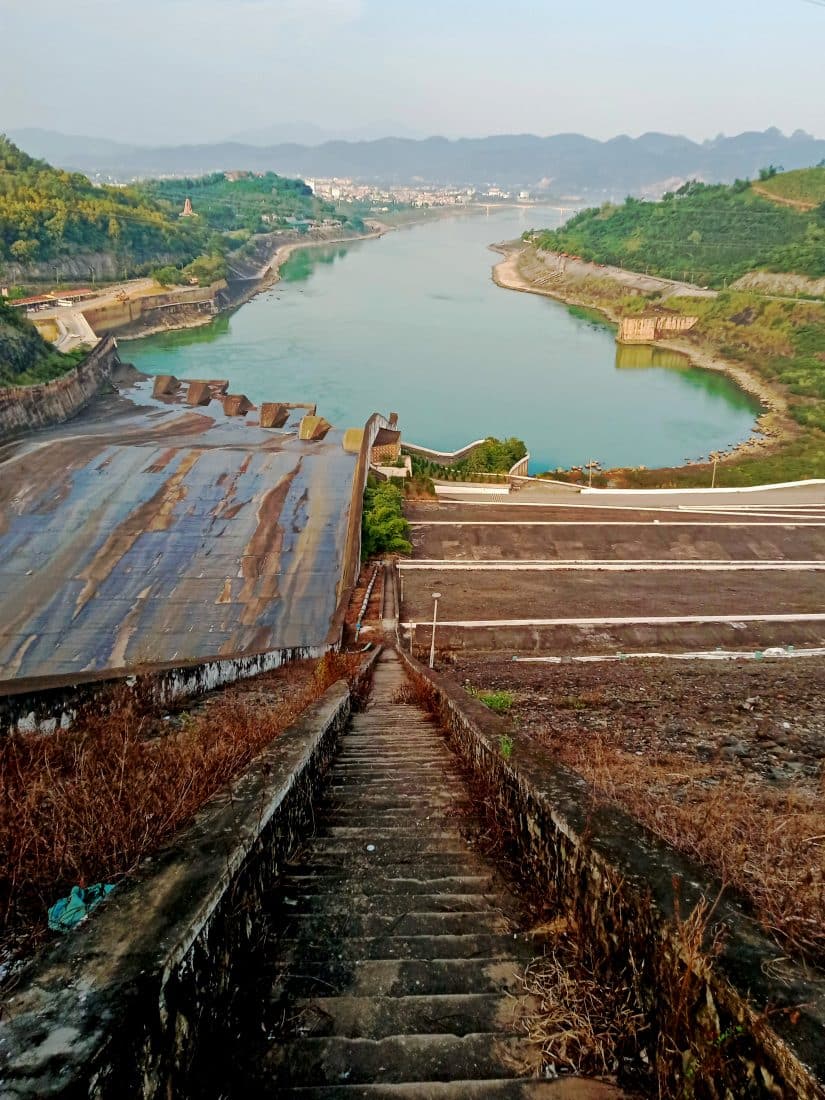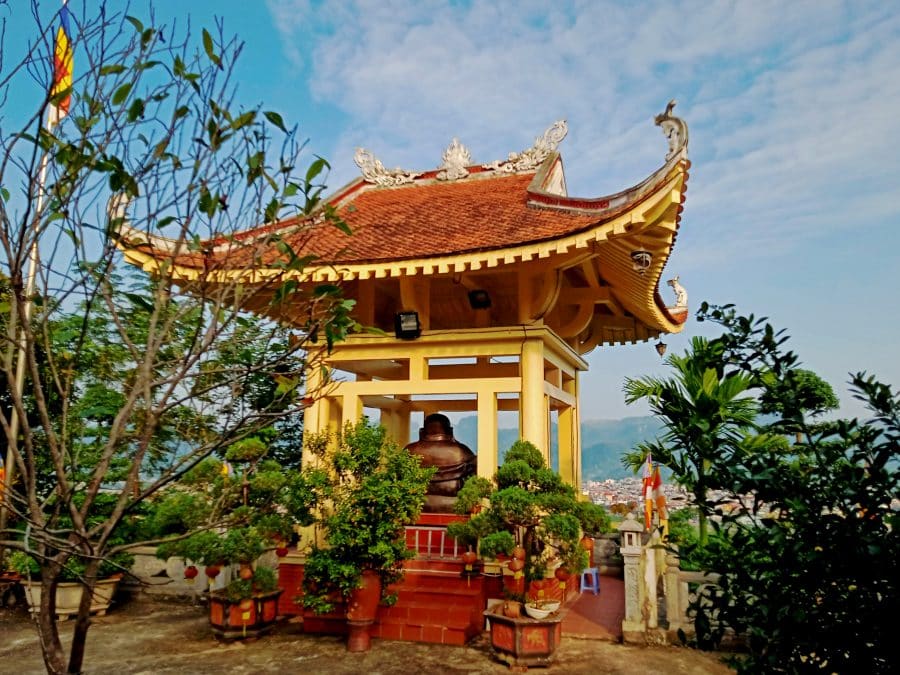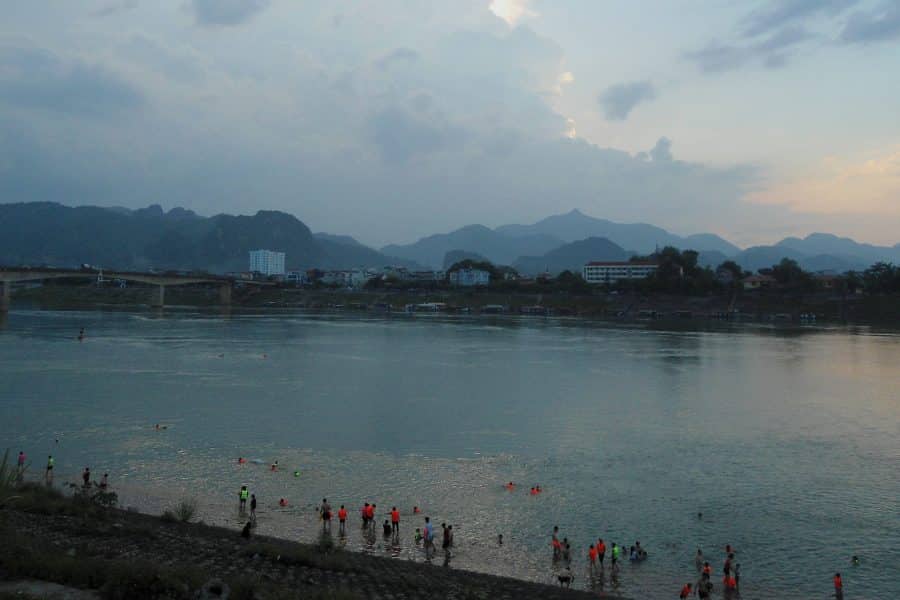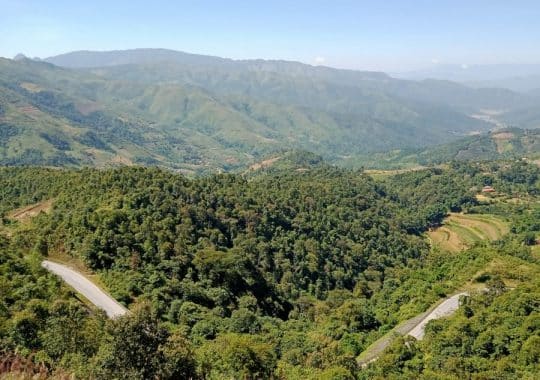Completed in 1994 after 25 years of construction, the Hoa Binh Dam and Power plant is a brilliant feat of engineering. The project was guided and financed by the Soviet Union who at the time of the cold war provided great assistance to Vietnam’s communist state. It is one of modern Vietnam’s greatest achievements and of course the main attraction of Hoa Binh city.
For riders, it is the perfect place to stop if you are motorbike touring west towards Mai Chau, Son La, or Dien Bien from Hanoi some 80 kilometres away. There are a couple of places to have a drink and check out the view and sheer magnitude of the structure near the bottom. During drier months the water is a beautiful aqua blue whilst in wetter months it becomes a muddy brown.
You can head up to the top of the dam wall for even more impressive views although at the time of writing you must provide identification and get the paperwork to go right up.

French aspirations for a Dam on the Da River
As far back as the 1930s French colonialists of then, Indochina had a desire to create a hydropower plant dam on the Da River. Over several decades the French explored lengths of the river, did geological surveys, and drilled into the river bed in pursuit of the project.
They were unable to locate a suitable location and with the limited technology of those times, the French found the construction of a dam, damn near impossible. Their main problem was that gravel and sediment layers were just too thick at the river’s bed. They did not give up on the idea with engineers still working up until the fall of Indochina which of course put an end to all such plans.
An interesting side-note is that of the French scientist Josué-Heilmann Hoffet. He undertook geological studies of Indochina and found the first dinosaur fossils in what is today Laos. In 1941 Hoffer became a professor at Hanoi University during intense times of war when Japanese forces were becoming involved in Indochina.
He is said to have surveyed parts of the Da River for the Department of Water Resources of Indochina but sadly died at a young age in 1945. Whilst working with a drilling team in Hoa Binh, he was taken captive by Japanese forces and later executed. Another version states that he died while fighting for the anti-Japanese resistance closer to Hanoi. So far we have been unable to verify which account of his demise is true but a man of his talents would have no doubt been involved in any prospective dam construction at the time.


Construction of the Dam
During the 1960s Vietnamese and Chinese geologists continued to study the Da River in the hope of building a dam but they were also incapable of finding a way to conquer it. However after the Soviets managed to complete the High Aswan Dam on the Nile River in Egypt, Vietnam invited Soviet Union specialists to examine the situation. The completed Egyptian Dam was able to overcome 200m of river bed gravel, much more than the 30-70m gravel, alluvium, and sand layers of the Da River.
In 1971 they began to draw a geological map of the river bed and in 1979 the construction of Hoa Binh Dam begun. It was required to build two stops to restrict the river with the first being completed in 1983 and the second phase was finished in 1986.
Underneath the Dam’s river bed site there were caves in the karst limestone, some up to 20m in height. Workers had to dig over 1500m of tunnels and use explosives to create a solid base. A single drill worker was set a target of 15m of tunneling each month – they got a bonus of a boiled pork meal if they managed to excavate 18m.


On one extra-large rock breaking exercise, 92 tonnes of explosives were placed into two holes and detonated from a kilometre away. The town of Hoa Binh was also evacuated. Soviet expertise in injection and jet-drilling techniques were used to shore up the river bed which was then sprayed in cement. Huge trapezoidal shaped blocks were then interlocked to create the initial foundations and were later covered in concrete.
The main body of the power plant was built underground in the mountainside. To create the cavern for the plant, 1.2 million cubic metres of rock were dug out to create a space that was 52m high, 22m wide, and 280 long. Inside this room 8 generators, powers transformers, and auxiliary works were fitted each being able to produce 240 MW.
168 people perished in the construction of the dam including 11 Russian nationals. There is a monument there to remember the fallen with all their names inscribed on a Stele, and 168 bowls to burn incense to them. On the road up there also a time capsule full of letters from people working on the project that is due to be opened in 2100.


The size of Hoa Binh Dam
It’s big, very big. Hoa Binh Dam wall measures 128 meters in height and at the top is 20 meters wide. It has a length of 820 meters at its base 620 meters at its crest. Its spillways can discharge a whopping maximum of 35,400m3 of water per second and the reservoir is said to have a capacity of a massive 9.8 billion cubic meters or 208km2. Since going into operation the power plant has produced about 230 billion kWh (November 2019) and currently averages 8.6 billion kWh each year.
The Hoa Binh area is quite prone to seismic activity therefore in order to counter-effect this they built what is known as a soft dam. A combination of clay, concrete, and rock were used to make the structure resistant to earthquakes up to the level of 8 to 9 on the Richter scale. It is said that the dam can withstand the equivalent of 4 atomic bombs comparable to the one dropped on Hiroshima by the USA in 1945.

The purpose of the dam
Hoa Binh Dam structure serves several main purposes:
The production of energy for the country – it is the most important power producer in the country at times in the past it has created up to one-third of Vietnam’s electricity on its own. Being able to provide and sell energy has of course brought with it great revenue for the state.
Flood control and water regulation – Vietnam experiences tremendous amounts of rain in its wet season and flooding has always been a problem to deal with. By some accounts, the 1971 floods of Hanoi and the Red River Delta claimed over 100 000 lives. The actual number is quite difficult to ascertain as the country was in the middle of a raging war with America at the same time.
Because the Da River provides approximately 55% percent of the Red River’s flow, regulating it is crucial to prevent major flooding in the country’s capital and beyond. After mass deluges in northern Vietnam in 2017, the dam got very close to maximum capacity and opened 8 discharge gates. Critical lower dyke systems stood up against the release although some 170 tonnes of cage farmed fish were killed.
Massive water release at Hoa Binh Dam in October 2017
It also assists with irrigation downstream in the Red River Delta. Some 30 000 ha of farmland there needs fresh water to push back saline estuary water levels that rise in the dry season.
Another benefit of achieving control of the river is improved transportation on water. On both sides of the wall, boats are now able to move more safely along the watercourse.

Hoa Binh Power Plant Expansion
The Hydropower plant is set to undergo an expansion operation in late 2020. This is most likely already underway as we saw workers reinforcing the mountain beside the dam the last time we visited. The development aims to add extra electrical capacity at a further 2 x 240MW bringing an extra 488.3 million kWh per year by 2023.
The existing dam wall, reservoir, and spillway will remain as they are- new water tunnels, discharge canals, and electrical systems will be created and fitted to coexist with the original design. The estimated cost of these upgrades is nearly 400 million USD.

Things to see at Hoa Binh Dam
If you go to the very top of the dam wall and follow the road uphill you will arrive at the Uncle Ho Monument. It is an 18-meter high statue of Ho Chi Minh the beloved former revolutionary leader and president of Vietnam. At the base of the figure is an inscription of poetry penned by Uncle Ho for a youth volunteer unit he visited in 1950. It reads:
Không có việc gì khó
Chỉ sợ lòng không bền
Đào núi và lấp biển
Quyết chí ắt làm nên
Nothing is difficult.
Only fear unstable heart.
Digging mountains and filling the sea.
There is a will to do
The translated version doesn’t read so well but the general essence of the poem can be understood – Through sheer willpower, determination, and persistence you can achieve your goals.
On one side the statue and overlooks the dam and the river behind it. On the other side, it overlooks Hoa Binh City and the river flowing away. It is a good spot for photos, on weekends and holidays it is a popular attraction for locals.

The small but beautiful Buddhist Phat Quang Pagoda (Chùa Phật Quang) can be found nestled at the top of a forested ridge on the power plant side of the dam. It is on a side road closer to the river about halfway up from the bridge. You will see an old, long decaying brick staircase when you get there, don’t be fooled into walking up as you can ride further and enter the complex at the top. There is a large bronze Buddha overlooking the river which is a great viewpoint. Among the gardens, there is also a large bell tower.
Downriver, towards the first bridge, you can rent life jackets and float downstream in the warmer months. It usually happens towards dusk and you’ll see Hoa Binh citizens floating along merrily on nice late afternoons.
For boating on the river behind the dam head to Thung Nai. The boat docks are about 20 km southwest of Hoa Binh city.






